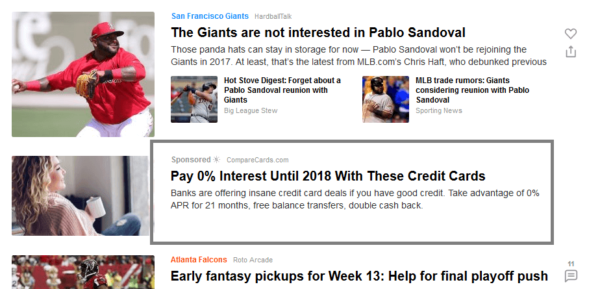How you should be leveraging native ads in 2017
Columnist Brad O'Brien takes a close look at native advertising, what it means for your brand and how it can drive results at every stage of the marketing funnel.
 As advertisers plan 2017 media budgets, native advertising needs to be a discussion point. While many interpretations exist, the most agreed-upon definition of native advertising is “a form of paid media in which the ad experience follows the natural form and function of the user experience in which it is placed.”
As advertisers plan 2017 media budgets, native advertising needs to be a discussion point. While many interpretations exist, the most agreed-upon definition of native advertising is “a form of paid media in which the ad experience follows the natural form and function of the user experience in which it is placed.”
Essentially, an ad is considered to be native when it looks like it was meant to be there. The form of the ad will match the visual aesthetics of the page or experience in which it is served. A native ad will behave and represent itself to function just like natural content.
Defining what native advertising means to your brand, and the teams and partners needed to be successful, will create a focused effort that goes beyond the buzzword.
There are generally considered to be four primary types of native ad integrations: in-feed native ads, content recommendation widgets, promoted listings and custom content units. I’ll explain the first two in further detail in this article.
For overview purposes, promoted listings include paid search results, marketplace results like Amazon and Etsy, or review-driven sites like Yelp. Custom content units typically involve working directly with publishers to create wholly unique ad experiences on the publisher’s site.
In-feed native ads

This type of native ad involves the placement of sponsored content within a publisher’s natural indexation of content. The promoted content takes on an identical look and feel of the surrounding in-stream content units.
In-feed native ads will disclose in some way that the content is sponsored or that the author is a brand advertiser so that readers can distinguish ads from other in-stream content.
A few examples of in-feed publisher platforms are Sharethrough, Yahoo Gemini and Nativo. These platforms work directly with publishers — and in the case of Gemini, its own properties — to serve branded content within editorial streams.
Most in-feed publisher platforms will direct the sponsored content to an off-publisher experience on the advertiser’s site or to an earned media placement. Others, like Nativo, offer a fully integrated experience, where the native ad is consumed on the publisher’s site.
Social media networks are also considered to be native advertising platforms. Whether it’s Facebook, Instagram, Twitter, Pinterest, Linkedin or Snapchat, each allows sponsored content within in-stream user experiences.
Similar to in-feed publisher platforms, some ad units will be an off-platform experience, and some will be contained within the social platform itself. Facebook’s lead and canvas ads and Snapchat’s sponsored filters are examples of native ad experiences that take place on the platform.
Targeting users within in-feed native ads will depend on which of the many in-feed platforms your content is being promoted on. Most can provide robust targeting options, and some support integrations with demand-side platforms, data management platforms and first- and third-party data.
Yahoo Gemini has some of the most interesting targeting options, which include search retargeting and mail domain retargeting. Search retargeting on Gemini involves serving native ads to users based on their Yahoo searches, and mail domain allows you to supply competitor domains (URLs) and target users who receive Yahoo mail from those domains.
Content recommendation widgets

These native ad integrations are typically displayed below an article or content feed, or along the right rail on publisher sites. The promoted content will be placed into a widget, rather than directly in-feed. These native ads feature various disclosure cues like “You Might Like,” “Sponsored Content” or “Recommended for You.”
Content discovery networks like Taboola, Outbrain, Revcontent and Disqus are among the most well-known content recommendation widgets. These networks have relationships with thousands of publishers to offer supplementary content to their readers, supplied by advertisers.
The experience feels very organic, with the publisher recommending relevant content to its readers. Content widgets will usually take a reader off-site to consume the advertiser’s content.
To help you reach the right users with your content, content discovery networks use a mix of contextual signals, as well as more advanced targeting options. In Taboola and Outbrain, a popular option is to first do a run-of-network and let their algorithms identify the users and publishers that are most likely to engage with your content.
Some advanced targeting options include custom audiences, third-party B2B and B2C segments, OS targeting, publisher inclusion or exclusion, sequential messaging, DMPs and DSPs and more.
Native advertising supports the whole funnel
While content promotion has most traditionally been thought of as a way to drive top-of-funnel brand discovery, awareness and engagement, a robust native advertising program can drive results at all stages of the funnel.
I suggest that your platform, targeting and content strategy for native be unique through awareness, consideration and conversion stages. I also tell my clients that content can mean many things and take on many forms (e.g., a single tweet, your home page, a video series, white papers, your app store experience).
Lastly, consider native advertising’s ability to augment your efforts across channels, delivering unobtrusive brand experiences at scale. When users have positive, valuable interactions with your brand, they will inherently say “yes” with greater frequency when presented with your marketing messages.
Native ads help nurture relationships with customers and potential consumers and create highly targeted remarketing pools. How are you going to leverage native ads in your 2017 media mix?
Contributing authors are invited to create content for MarTech and are chosen for their expertise and contribution to the martech community. Our contributors work under the oversight of the editorial staff and contributions are checked for quality and relevance to our readers. MarTech is owned by Semrush. Contributor was not asked to make any direct or indirect mentions of Semrush. The opinions they express are their own.
Related stories
New on MarTech